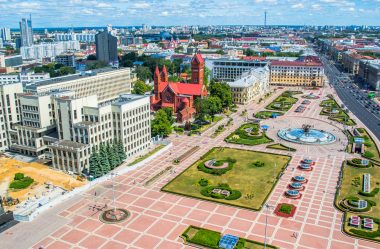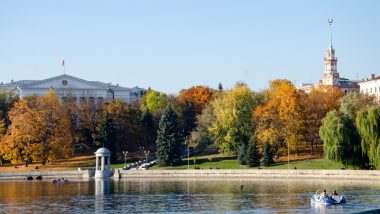Appeal to Minsk as a holiday destination? Anyone who says such things is quickly faced with a persistent frown. Because in our latitudes, the capital of Belarus is not necessarily one of the top destinations for a city trip. But the city has a lot to offer. It is bursting not only with lofty buildings, but also with culture and a good dose of post-communism.
Freedom Square in the Upper Town

The center of the city is undoubtedly Freedom Square, which is located in the heart of Minsk. The historic center of the city has been repeatedly destroyed by disasters such as fire and wars. But as a result, many of the destroyed buildings were rebuilt true to the original and still give an impression of the beauty and splendor of that time. This includes the Old Town Hall, the first version of which was built in the 16th century.
It has been the victim of fires several times, but has always been rebuilt. Tsar Nicholas I had it completely demolished in 1857. Shortly after the turn of the millennium, it was rebuilt according to historical plans. Opposite is the Catholic Cathedral of the Name of Mary. Originally a Baroque building, built in 1710 as a Jesuit church, the cathedral was redesigned again and again after 1798. Inside, it is now in the Rococo style.
The National Art Museum of the Republic of Belarus
This museum is the largest in Belarus, and includes a collection of more than 30,000 works of art. The house, which is housed in two different buildings, has two large departments: National Art and International Art. Visitors can learn about the complete history of Belarusian art. Russian artists from the 18th to the early 20th centuries are shown as well as Western European painting from the 16th to 20th centuries. Here there is a focus on Flemish landscape painting. The Oriental Collection with works of art from the 14th to the 20th century is unique.
Gorky Park

Visitors enter the public city park Gorki-Park through a mighty entrance gate, which is somewhat reminiscent of the Brandenburg Gate. As early as 1800, the park was opened to the public under its then name “Governor’s Garden”. The renaming to Gorky Park, after the Russian poet Maxim Gorky, occurred during the Soviet era, when many public parks throughout the Soviet Union were given this name. The central point of the park is a 54-metre-high Ferris wheel, which has been integrated into the park’s own amusement park. There is also an ice rink, a planetarium and an observatory. In summer, the park is especially popular with families, because then children can go riding here guided and supervised.
The Central Botanical Garden
In the green oasis of Minsk, there is a rather adult audience. Minsk is teeming with parks and green spaces, but the Central Botanical Garden is probably the most beautiful green place to go. The highlight is a large-scale exhibition of rare and endangered species of medicinal plants, aromas and aquatic plants. These do not only come from the local area. Many have their real home in the Far East, in Siberia, in the Crimea, in the Caucasus and in Central Asia, in East Asia and in North America. On the one hand, the Orangery is a paradise for citrus plant lovers. On the other hand, tropical and subtropical plant species can be viewed here. All around there are numerous green areas that invite you to take a walk and even a small lake.
The National Library of Belarus
On the Founded on 15 September 1922, the National Library of Belarus was initially used as a university library. At that time, the eight million media were stored in another building. In 1989, it was decided to build a new library, and this is a visual masterpiece. On the On 16 June 2006, the 72-metre-high and 23-storey building was handed over to its intended purpose. It bears the shape of a huge rhombic cuboctahedron. Diamonds are also cut in this form, which is why the building is also known as the “Diamond of Knowledge”. At night, the library is colorfully illuminated by numerous light sources and thus actually looks like a shimmering gemstone. It is certainly one of the most architecturally interesting buildings in the city.
The Belarusian State Circus
Like many other post-Soviet states, Belarus also has a permanently installed circus building as well as a state circus. The round building dates back to 1959. Inside, there are four different floor coverings, which can be used in a differentiated way by a circus. There is an area for ice shows and one for light shows. The area, which is equipped with rubber covering, is mainly used for animal shows. There is also an area with high-quality parquet: artistic demonstrations take place here. The program is renewed every two months.
The Belarusian National Museum of History and Culture
This museum is extremely comprehensive and has five different sections. The Museum of the History of Belarusian Cinema, the Museum of the First Congress of the RSDLP, the Museum of the History of Theatre and Music Culture of Belarus, the Museum of Nature and Ecology and the Museum of Modern Belarusian Statehood. Each visitor can set their own priorities, because one weekend is by no means enough to wander through all departments. Items of clothing, uniforms, coins, books, weapons, archaeological finds, porcelain, watches, furniture and much more are on display. The department for icon painting is particularly worthwhile.


